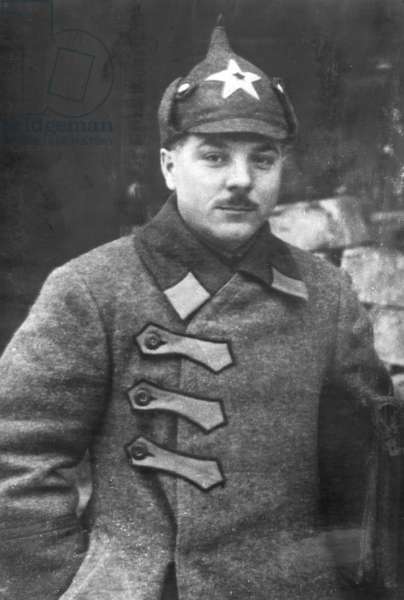I just realized I have no idea why this happened. Does anyone have a good dialectical materialist explanation?
Afaik the temperance movement had a large faction of women who correctly identified alcohol as a cause of domestic violence. And, from what i understand, alcohol consumption was considerably higher before prohibition than it ever was after, so i imagine things really were quite bad.
that’s definitely part of it, and played a role in women’s suffrage
The only hope of the Anti-Saloon League’s success lies in putting the ballot into the hands of women. --Susan B. Anthony
and this is an opportune moment to highlight one of my favorite temperance movement members: hatchet granny
for years she tried to dissuade people from drinking or providing alcohol, but since that didn’t work she eventually resorted to just attacking bars and taverns with a hatchet and destroying their alcohol supplies
Nation died on June 9, 1911. She is buried in the southeastern side of Belton Cemetery in Belton, Missouri. The Woman’s Christian Temperance Union later erected a stone inscribed “Faithful to the Cause of Prohibition, She Hath Done What She Could” and the name “Carry A. Nation”.
I’ve seen signs in bars saying “we serve all nations except Carrie” and never knew what it meant
That was the reason a lot of women join those orgs, but a lot of the women leading the Progressive movement had very eugenicist views. All of it is put through this lens of dealing with social ills by “fixing” the uncivilized. So they rope in women who want to stop abuse from happening, into supporting efforts that destroy labor organizing, and essentially make young women wards of these Puritanical nativists.
Like Settlement Houses which Protestants in the UK and US created often out of a genuine desire to see immigrant women not go into prostitution or starving on the streets in unhygienic conditions, just as implicitly saw their purpose as a sacred duty to maintain “social hygiene” and assimilate or isolate undesirables. This is the same trend that led to birthcontrol in the US being popularized by some in order to curtail minority birthrates.
A lot of this came from wellborn white women who earnestly wanted to vote and develop women’s spheres of politics and social development, but whose views are inextricable from eugenics. So good social reforms are part of this larger system of “uplifting” lesser people. https://scholarship.law.duke.edu/cgi/viewcontent.cgi?article=1541&context=lcp
One understated reason that it gained momentum was that it was an outlet for popular nativist sentiments by WASPs (especially among the middle class) against the wave of newly arrived immigrants from cultures where social drinking was more common. Some Progressives at the time viewed the elimination of social drinking through Prohibition and the closing of the Saloons associated with immigrant drinking as a step towards assimilating the urban immigrant population into WASP social norms. Some among the Progressives spoke of this culture in medical or even eugenic terms as some contagion that was associated with the immigrants that must be stopped to prevent some sort of “degeneration” of society that would come with the adoption of drinking and drinking culture by WASP America. These reactionary sentiments would see their apogee in the 1920s, where there was an alliance in the South and rural Midwest between the KKK and local Anti Saloon League chapters to enforce local Prohibition.
Prohibitionist anti immigrant attitudes also got a jolt of support when America entered WWI and the beer-distilling sections of the German-American community became a target for pro-war sentiments.
Though I must say that anti immigrant sentiment was only one facet of the many intersecting prejudices of early 20th century America that influenced the law’s adoption. You could also see cause from a desire to reinforce patriarchal social relations, strengthen existing regimes of racial segregation, or even as a way that capital sought to impose standards of discipline on labor (see Henry Ford’s Sociological Department). Basically (as others have stated) many of these reasons boil down to the reactionary ideology of middle class America.
If puritan muricans spawned from puritan britbongs, I still can’t understand how britbongs would gove up booze. Look at those gammons their heart would explode if they went throu detox
Class resentment was sublimated via local christian cults

i guess the simple answer would be the temperence political mobilization was centralized and utilized modern communication networks along with newly relevant demographics (women)
while the liquor-related capital was extremely disparate and unconsolidated. you had hospitality capital, wholesale capital, farmers & producers—all relatively small scale & at odds on other issues.
i think if as much agitation had been applied to say, rail industrialists (and it probably was, tbh) the same result would not have occurred, because the rail cartel acted collectively in its interests
Ideology

I did a write-up on this site about this a long time ago with excerpts from a fantastic sociological paper from the turn of the century
The mass push against alcohol was as a means to alleviate fears of immigrants, working class folks, and Catholics by a predominantly Protestant population who was beginning to lose a sense of control. They did some good stuff like raising the age of consent in laces, but broadly it was a religious movement from the dominant religion and race, attempting to close down establishments that became a refuge of immigrants, union activity, and other “uncivil” stuff.
There was certainly a well-intentioned aspect to it for most members, particularly women, but the undercurrent was always suspect imo, more like it dragged along actual concerned people. Saloons being busted was pushed for by the temperance movement with the help of the police and bosses in order for the latter two to be able to crush the rise in unions and other worker comradery occurring in these places after work.
Fantastic summary of the role of saloons as social institutions of the working class in Chicago from 1900 http://historymatters.gmu.edu/d/5765/
In the statement, now current among those who have studied the saloon “at first hand,” that it is the workingman’s club, lies the secret of its hold upon the vast working and voting populace of Chicago. That same instinct in man which leads those of the more resourceful classes to form such clubs as the Union League Club, or the Marquette Club; which leads the college man into the fraternity, leads the laboring men into the clubs furnished them by the saloonkeeper, not from philanthropic motives, but because of shrewd business foresight. The term “club” applies; for, though unorganized, each saloon has about the same constituency night after night. Its character is determined by the character of the men who, having something in common, make the saloon their rendezvous. Their common ground may be their nationality, as the name “Italian Headquarters” implies; or it may be their occupation, as indicated by the names “Mechanics’ Exchange,” "Milkman’s Exchange,“ etc.; or, if their political affiliations are their common ground, there are the ” Democratic Headquarters of the Eighteenth Ward,“ etc. As shown above, the ”club-room“ is furnished with tables, usually polished and cleaned, with from two to six chairs at each table. As you step in, you find a few men standing at the bar, a few drinking, and farther back men are seated about the tables, reading, playing cards, eating, and discussing, over a glass of beer, subjects varying from the political and sociological problems of the day to the sporting news and the lighter chat of the immediate neighborhood. Untrammeled by rules and restrictions, it surpasses in spirit the organized club. That general atmosphere of freedom, that spirit of democracy, which men crave, is here realized; that men seek it and that the saloon tries to cultivate it is blazoned forth in such titles as ”The Freedom,“ "The Social,” “The Club,“ etc. Here men ”shake out their hearts together.” Intercourse quickens the thought, feeling, and action.
In many of these discussions, to which I have listened and in which I have joined, there has been revealed a deeper insight into the real cause of present evils than is often manifested from lecture platforms, but their remedies are wide of the mark, each bringing forward a theory which is the panacea for all social ills. The names of Karl Marx and leaders of political and social thought are often heard here. This is the workingman’s school. He is both scholar and teacher. The problems of national welfare are solved here. Many as patriotic men as our country produces learn here their lessons in patriotism and brotherhood. Here the masses receive their lessons in civil government, learning less of our ideals, but more of the practical workings than the public schools teach. It is the most cosmopolitan institution in the most cosmopolitan of cities. One saloon advertises its cosmopolitanism by this title, “Everybody’s Exchange.” Men of all nationalities meet and mingle, and by the interchange of views and opinions their own are modified. Nothing short of travel could exert so broadening an influence upon these men. It does much to assimilate the heterogeneous crowds that are constantly pouring into our city from foreign shores. But here, too, they learn their lessons in corruption and vice. It is their school for good and evil. …
The adaptability of the saloon to the needs of a particular locality is a source of constant surprise and admiration, as it is also a cause of genuine consternation among Christian people who reflect at all upon the cautious institutionalism of the churches.
As with much of the Progressive Era, the reforms came from a place of social order and to some extent social-Darwinism. Poverty was caused by drink, not the bosses, Abuse was caused by drink, not by the patriarchal society, drink was the reason the immigrants are bad and must be “cleansed” and made American or have their kids taken away. Drink caused workers to earn lower wages cause slaking, not the system of wages itself being a shackle upon working people.
https://offtheleash.net/2017/12/19/prohibition-as-class-warfare/
They were joined by businessmen, industrialists, the hierarchy of the Protestant Churches and the descendants of the Southern landed gentry. The Anti-Saloon League, a Protestant church-based Ohio organization that became a driving force in bringing about Prohibition, didn’t get all their money by passing around the collection plate. John D. Rockefeller kicked in $350,000. Henry Ford and Andrew Carnegie backed them as well.
Even if it cited actual social-ills, temperance was built upon anxieties over immigration, religion, and class. It is pretty comparable to any other case of concern trolling or using a social issue for one’s own ends or protection of the hegemons.
So the materialist analysis is that this is all in the context of increased proletarian immigration from majority Catholic nations who brought with them a tradition of labor organizing and in order to survive in the US began living more closely with their neighbors. This created anxiety and saloons became a signifier of labor unrest, immigrants, and Catholics and would be blamed by bosses for strikes being organized and by Progressives for any and all social ills.
There was certainly an element of genuinely combatting abuse, but this was the progressive era, any social ill that was combatted came with a dozen horrible things and had an element of social hegemony. I am pretty proud of this part of my original comment
Poverty was caused by drink, not the bosses, Abuse was caused by drink, not by the patriarchal society, drink was the reason the immigrants are bad and must be “cleansed” and made American or have their kids taken away. Drink caused workers to earn lower wages cause slaking, not the system of wages itself being a shackle upon working people.
I recently bought a book “through jaundiced eyes” about how political cartoons depicted workers in the US, havent read it yet, but a BIG part of anti-labor cartoons just from prior courses I have taken is drunken stereotypes. This is why the Irish stereotype of being a drunkard exists
Thank you for the citations. I’m gonna read about this the next few days
On top of the many excellent points raised here, the temperance movent also grew in response to the industrialization of distilled spirits. Mechanization and standardization meant high proof alcohol became easier to produce, and in larger quantities. The cost of production dropped as well, making the distilled drug (and alcohol is a drug) widely available and much more affordable. In response, alcohol consumption skyrocketed. This all happened over the course of a single lifetime, roughly from after the civil war.
…i’d apologize for posting on an old thread, but i’m not actually sorry
It’s ok, I had thought about that too. Alcohol went from something distilled by your neighbor in big wooden barrels to something distributed by factories.
Mechanical refrigeration was invented in 1874 and a professor once described it to me like “Brewering ceased to be a specialized, artisal profession like a chef and became more like being a mechanic.” The process became more streamlined during the 1880s and 90s, and that’s right when the temperance movement was gaining steam
It’s funny, back when brewing/distilling was more an artisanal craft, being able to consistently recreate a product was a mark of high achievement. Now, its the opposite. A bottle of jack is a bottle of jack, whether you bought it yesterday or last decade; now all the collectors want the ‘unique’ single barrel stuff that wont taste quite like the regular stuff.
My professor (a chemist with a specialization in fermentation chemistry) explained it something like it’s very difficult for large scale manufacturers to produce alcohol that’s exactly the same every time. Brewing is a finicky process where a slight pH imbalance or just a single cell of bacteria will ruin entire batches. So large scale breweries will produce a very consistent, very exact terrible product. Bud light always tastes the same. Whereas small scale brewers will sort of embrace the chaotic randomness that comes with it
Yeah, as I understand it, the way you make liquor taste the same is to dump all the barrels into one large vat, mix, then bottle. Takes all the minor inconsistencies and just smooths them together until it’s dry, if you pardon the pun.










